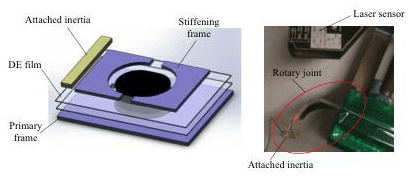New Discovery Has The Potential To Build Flapping Robotic Wings
Dielectric elastomers (DEs) are smart material systems that are commonly used for building actuators or motors that convert electrical energy into mechanical work efficiently. A kind of electro-active polymer, DEs have soft and lightweight properties. They are widely used for developing devices or gadgets such as robotic hands, soft robots, tunable lenses and pneumatic valves. Like human muscles, they can even go through active deformations on applying static or stable voltages to them. However, there is a limitation to this process. While stimulating the artificial joint motion by applying static voltage, the joints are able to bend but at fixed angles only. So, scientists studied the reactions of the joint by passing alternating voltages. Later, they found out that the joint can make more flexible bends by alternating them up and down, like a flapping wing.

The researchers from Harbin Institute of Technology in Weihai, China and University of California, Los Angeles (UCLA) discovered that this new resonance phenomenon in DE joint helps it to bend continuously even at negative angles (more than 90 to 180 degrees). The team used square-wave voltage because it was able to uninterruptedly manipulate and handle bending angles of the joint during the shift between different values of the applied voltage. Only when the rotational inertia of the joint is large enough or the applied voltage is high enough, the joint was able to make such negative angles. Owing to the continuous change in voltage, the angle of the joint changes dynamically making DE minimum-energy structure a useful one for fabricating soft devices.
According to the team, the new principle is not like normal resonance rule and is called nonlinear oscillation. Its joint amplitude, also known as the bending scope, is large compared to that in normal resonance. While aiming for largest bending angle of the artificial joint, the voltage frequency in nonlinear oscillation is slightly smaller than twice the joint's natural frequency.
Due to the features such as high energy density and high-energy conversion efficiency (about 60 to 90 %) along with the newly discovered principle, it will be possible to build soft and lightweight flapping wing for robotic birds and other energy-efficient devices. In order to make a tangible flapping wing, the team wants to further improve the dielectric elastomer rotary joint and upgrade the fabrication technique. The study was published in the journal Applied Physics Letters, this week.
Source: #-Link-Snipped-#
The researchers from Harbin Institute of Technology in Weihai, China and University of California, Los Angeles (UCLA) discovered that this new resonance phenomenon in DE joint helps it to bend continuously even at negative angles (more than 90 to 180 degrees). The team used square-wave voltage because it was able to uninterruptedly manipulate and handle bending angles of the joint during the shift between different values of the applied voltage. Only when the rotational inertia of the joint is large enough or the applied voltage is high enough, the joint was able to make such negative angles. Owing to the continuous change in voltage, the angle of the joint changes dynamically making DE minimum-energy structure a useful one for fabricating soft devices.
According to the team, the new principle is not like normal resonance rule and is called nonlinear oscillation. Its joint amplitude, also known as the bending scope, is large compared to that in normal resonance. While aiming for largest bending angle of the artificial joint, the voltage frequency in nonlinear oscillation is slightly smaller than twice the joint's natural frequency.
Due to the features such as high energy density and high-energy conversion efficiency (about 60 to 90 %) along with the newly discovered principle, it will be possible to build soft and lightweight flapping wing for robotic birds and other energy-efficient devices. In order to make a tangible flapping wing, the team wants to further improve the dielectric elastomer rotary joint and upgrade the fabrication technique. The study was published in the journal Applied Physics Letters, this week.
Source: #-Link-Snipped-#
0
